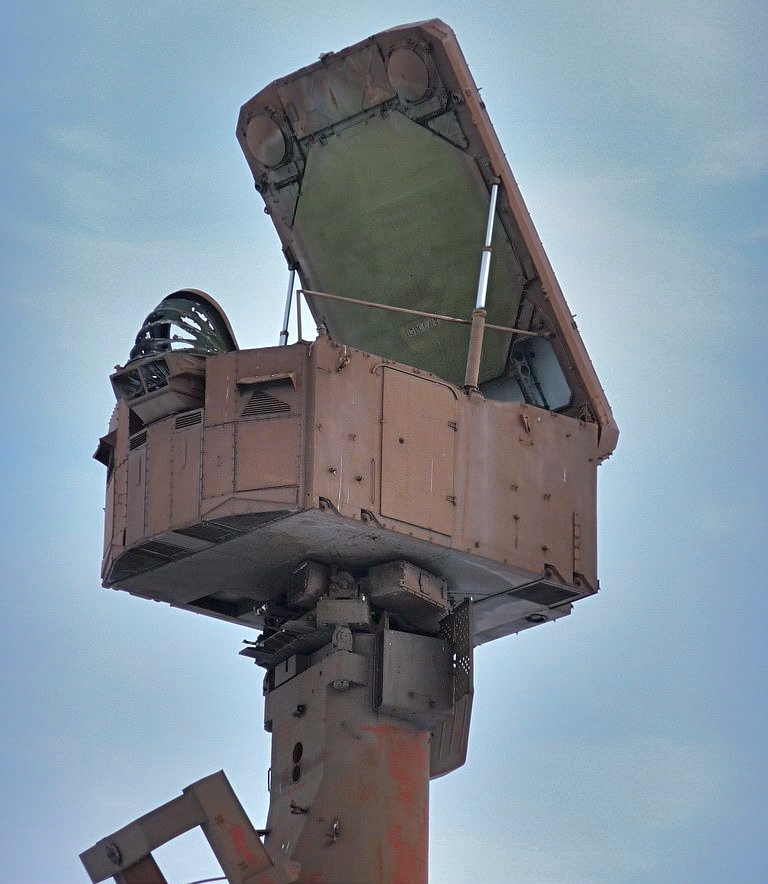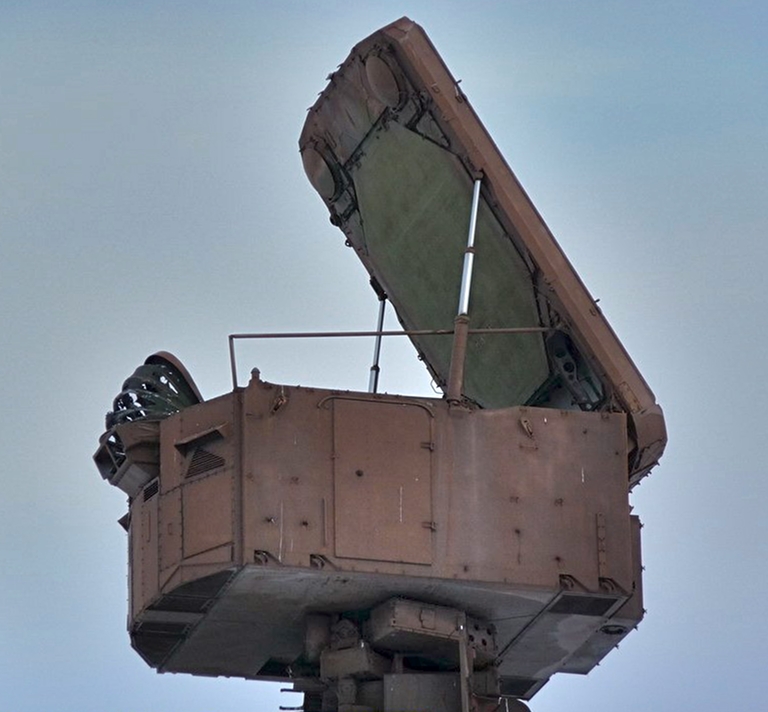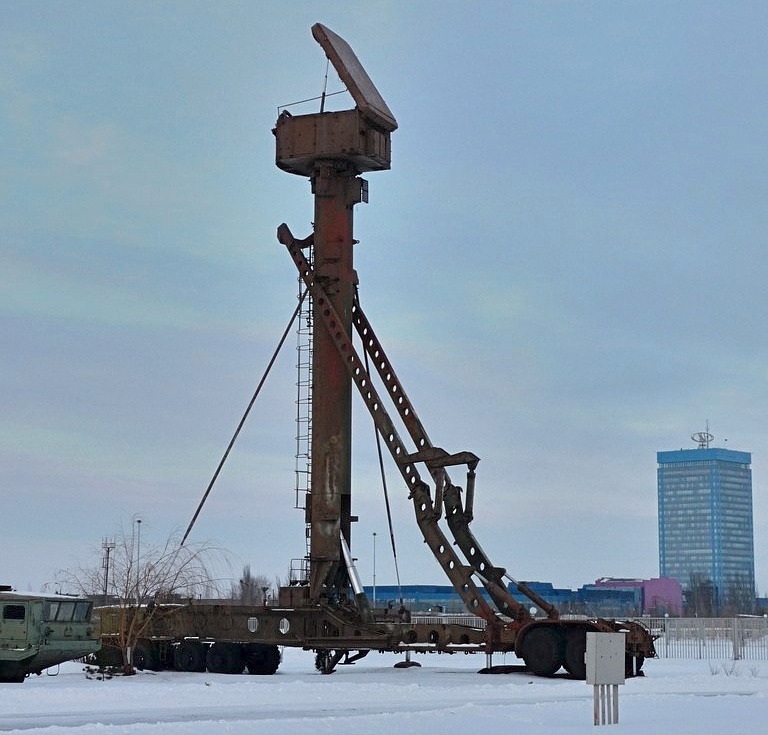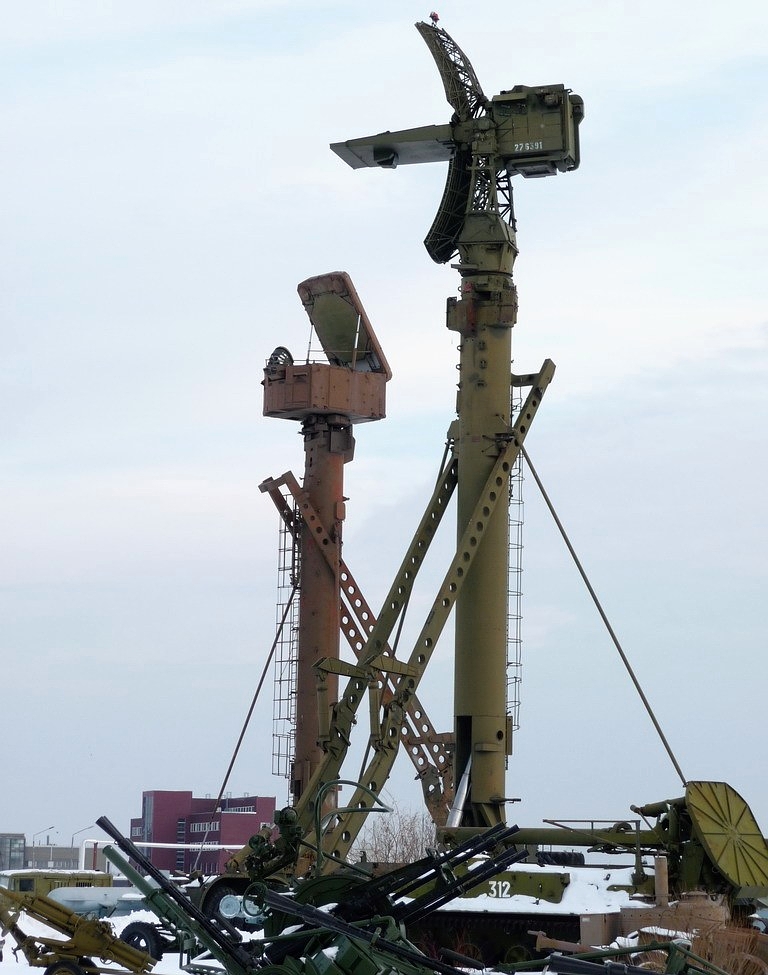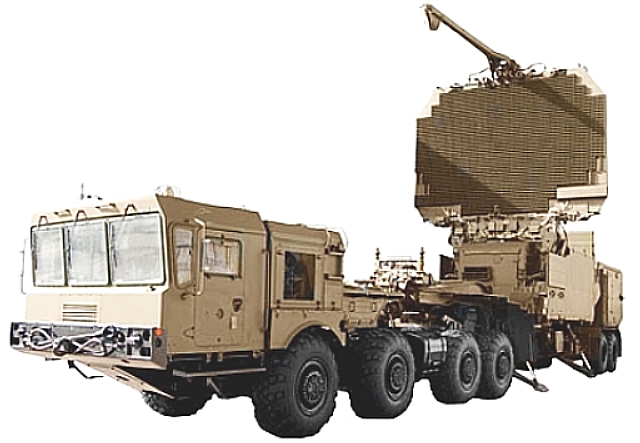X-band radars wrt RCS ...
The 92N6 Grave Stone multimode engagement radar is a significant redesign of the Flap Lid / Tomb Stone series with fully digital processing and increased power-aperture performance (image © Miroslav Gyűrösi).
The diverse Flap Lid family of radars are Russian equivalents to the US MPQ-53 Patriot engagement radar. The first generation of the S-300P's 5N63 (later 30N6) Flap Lid A engagement/fire control radar was innovative, and clearly influenced by the Raytheon MPQ-53 engagement radar for the MIM-104 Patriot. The Flap Lid, like the MPQ-53, uses a transmissive passive shifter technology phased array, with a space (a.k.a. optical) feed into the rear plane of the antenna. The Flap Lid's antenna stows flat on the roof of the radar cabin, which was initially deployed on a trailer towed by a Ural-357, KrAZ-255 or KrAZ-260 6x6 tractor. The whole radar cabin is mounted on a turntable and used to slew the phased array to cover a 60 degree sector of interest.
The 5N63 was a huge generational leap in technology from the Fan Song, Low Blow and Square Pair mechanically steered and scanned engagement radars on preceding V-PVO SAMs. With electronic beam steering, very low sidelobes and a narrow pencil beam mainlobe, the 30N6 phased array is more difficult to detect and track by an aircraft's warning receiver when not directly painted by the radar, and vastly more difficult to jam. While it may have detectable backlobes, these are likely to be hard to detect from the forward sector of the radar. As most anti-radiation missiles rely on sidelobes to home in, the choice of engagement geometry is critical in attempting to kill a Flap Lid.
Unlike the Patriot's MPQ-53 engagement radar which has substantial autonomous search capability, the 5N63 is primarily an engagement radar designed to track targets and guide missiles to impact using a command link channel. The absence of dedicated directional antennas on this system indicates that the commands are transmitted via a specialised waveform emitted by the main array. The first generation of the 5V55K missile was command link guided, following the design philosophy of the S-75/SA-2 and S-125/SA-3, with a cited range of 25 nautical miles and altitude limits between 80 ft and 80,000 ft.
Growing US electronic combat and SEAD capabilities, in the EF-111A Raven and F-4G Weasel forces were clearly considered a serious threat and this spurred the further evolution of the S-300PT system. In 1982 the V-PVO introduced a fully mobile variant of the system, designated the S-300PS (P- PVO, S - Samochodnyy/Self-propelled), labelled by NATO the SA-10B. The S-300PS saw the 5N63 Flap Lid engagement radar transplanted on to the high mobility 8x8 MAZ-7910 vehicle derived from the MAZ-543. The rehosted radar became the 5N63S Flap Lid B (Samochodnyy/Self-propelled). This permitted the engagement radar and TELs to set up for firing in 5 minutes, and rapidly scoot away after a missile shot to evade US Air Force Weasels. The improved 5N63S Flap Lid B radar had the capability to concurrently engage six targets, and guide two missiles against each target. The phased array beam steering angular range was extended to permit instantaneous coverage of a 90 degree sector, comparable to the SPY-1 Aegis radar.
The next big evolutionary step in the S-300P system was the introduction of the enhanced S-300PM and its export variant the S-300PMU1/SA-10D, in 1993. The SA-10D, later redesignated SA-20 Gargoyle, was subjected to what Russian sources describe as a deep modernisation with design changes to most key components of the system. The aim was to improve its basic capabilities as a SAM, extend radar and engagement footprints, increase the level of automation in the system, and introduce an anti-ballistic missile capability against ballistic missiles with re-entry speeds of up to 2.8 km/sec. Incremental changes were made to the Flap Lid, yielding the 30N6/30N6-1 Tomb Stone variant, designated 30N6E1 for export, capable of guiding the new 48N6 missile, the manufacturer claims an ability to engage targets with an RCS as low as 0.02 square metres at an unspecified range, and an autonomous search capability. The 30N6E1 retains the capability to deploy on the 40V6M mast.
Further evolution of the S-300P design took place between 1995 and 1997, yielding the S-300PMU2/SA-10E Favorit system, later redesignated SA-20 Gargoyle, intended to compete directly against the Antey S-300V and Patriot PAC-2/3 systems as an Anti-Ballistic Missile system. The Favorit incorporates incrementally upgraded 30N6E2 Tomb Stone engagement radar. The Favorit's new command post has the capability to control S-300PMU / SA-10, S-300PMU1 / SA-20 batteries, and also S-200VE/SA-5 Gammon batteries, relaying coordinates and commands to the 5N62VE Square Pair guidance and illumination radar.
The most recent derivative of the S-300P family of systems is the S-400 Triumf or SA-21. The 30N6E2 further evolved into the more capable 92N2E Grave Stone, carried by a new 8 x 8 MZKT-7930 vehicle. The additional range required a significantly uprated transmitter tube to provide the higher power-aperture performance needed, in additional to an improved exciter and automatic frequency hopping capability.
A 2008 diagram published by Almaz-Antey showing the composition of an S-400 battery.
An excellent study of the 5N63 Flap Lid A deployed on 40V6M semi-mobile mast system by Said Aminov, produced at the Togliati Museum in Russia (© 2009, Said Aminov).
Above, below, detail of the 5N63 Flap Lid A F1 radar head module deployed on 40V6M semi-mobile mast system, by Said Aminov, produced at the Togliati Museum in Russia. The dual plane monopulse circular polarised primary feed has been stripped and the concertina shroud has deteriorated. The operator consoles are in the F2 module, typically located on a truck. Later self-propelled 5N63S Flap Lid B variants retained the capability to deploy the F1S module on the 40V6M/MD mast, with the F2S module remaining attached to the MAZ-7910 8x8 vehicle chassis (© 2009, Said Aminov).
Above: 5N63 Flap Lid A deployed on 40V6M semi-mobile mast system by Said Aminov, produced at the Togliati Museum in Russia; below: 5N63 Flap Lid A co-deployed with a 5N66M Clam Shell, a common arrangement at static Soviet PVO sites requiring low altitude engagement capability (© 2009, Said Aminov).
Above, below: early model 5N63 Flap Lid towed variant on display at the Moscow District PVO Museum at Zarya, near Moscow. Note the exposed polarisation screen in the space feed (Images ©
Miroslav Gyűrösi).






